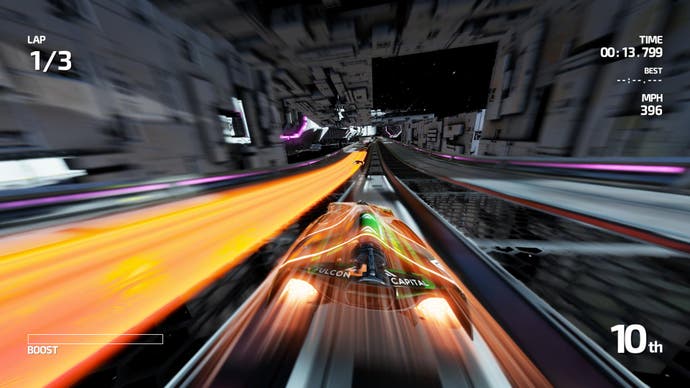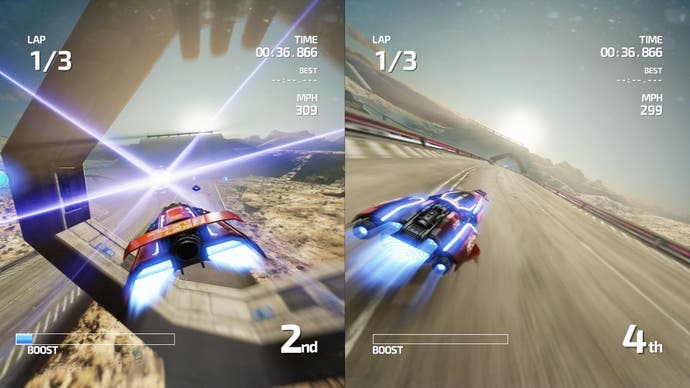Fast Racing Neo review
F-Nero.
How we long for an update to Nintendo's F-Zero, so untapped, so overdue. The most recent major update to the futuristic racing series launched 12 years ago. It was an ambitious and, in terms of velocity, still unrivalled collaboration between the company's star designer Shigeru Miyamoto and Sega's Toshihiro Nagoshi, thoroughbred creator of racing benchmarks Virtua Racing and Daytona USA. In F-Zero GX, the rival companies came together for the first time: Nintendo's talent for character and sheen fused with Sega's natural genius at high speed. It remains a classic. Time has passed, expectations have mounted but there remain only rumours. In the series' parlance, F-Zero has been 'retired'.
Shin'en, a German developer in Japanese clothing, has refused to accept this verdict. Fast Racing Neo may have a terrible title but, as a slickly quick tribute to the absent racer, it's a welcome and competent substitute. This is not so much a cut-price F-Zero as a hyper-trimmed homage. Almost all extraneous elements have been discarded (presumably for budgetary reasons). Yet, on the track, there has been minimal skimping. There are only ten competitors, compared to F-Zero GX's ludicrous thirty, but in terms of snap-neck speed, vertiginous and varied tracks that demand to be sight-read at prestissimo pace, and fortunes that can turn on a single ill-timed boost, Fast Racing Neo makes for a pleasing cover version.
It's not all copy-and-paste design. Neo's principal novelty borrows from an unlikely source: the shade-switching arcade shoot-'em-up, Ikaruga. As in Treasure's classic, your craft has two colour schemes that can be flipped between with a single button press. Each track is painted with intermittent colour strips, either throbbing blue or pulsing orange, which match the dual colours of your ship. Travel over the strip while decked in the corresponding livery and you earn a screen-smearing boost. Hit the strip while wearing the opposite colour and you'll slow to a flow-puncturing crawl.

The trick is to keep abreast of the designers' layouts - blue, blue, orange, blue - tapping out a rhythm of colour-switching while simultaneously keeping control of the craft on the track. Further boost power is provided by speed orb pick-ups liberally sprinkled around the track, which give you the option of when to slam your craft into overdrive. It's a strong design that deepens the otherwise straightforward racing, but one that falls a little short of F-Zero's ingenious risk/reward system, whereby your boost power was also your ship's shields.
The main game presents three tournaments, each of which has a quartet of cups comprised of four courses apiece. The game's tracks are its stand-out asset, offering a delicious variety of scenes, most of which have a short-cut or two to discover. Kenshu Jungle, with its bowling-lane-tight funnels, is juxtaposed with Sunahara Desert, a borderless track on which you must be careful not to hit corners at too high a speed and streak off uselessly into the sand. As in F-Zero, one track is set in space, with lingering jumps through zero-gravity sections of track studded with lumbering asteroids. As well as contending with serpentine roads, you must also cope with vision-clouding weather effects and, on many courses, dynamic obstacles such as waterfalls, meteor showers and rock avalanches.
You start off with a choice of three ships to pilot, a number that eventually grows to 10 as you complete each tournament. Each has a unique balance of weight, top speed and acceleration (F-Zero, remember, allowed you to set the balance between speed and acceleration yourself). As in Sony's Wipeout, ships come from a range of different fictional manufacturers with future-industrial names like Spaar Unlimited and Fulcon Capital, each of which has its own Designer's Republic-style knock-off logo.

The backstory is undernourished. There is no sense of F-Zero's pilot personalities or Wipeout's range of aesthetics and weaponry. The budget, seemingly, did not stretch that far. The options are nevertheless meaningful. It might be tempting to take, say, the Fulcon into a tournament, thanks to its near-maximum speed and acceleration statistics. But without careful air-braking, the machine's weight will see you lose far more seconds than you gain as you slam into barriers or spin out.
F-Zero is a famously challenging series, but its learning curve always accommodated beginners. There are no such concessions made in Fast Racing Neo, which feels like a game that's been unwisely balanced by a team of experts. The smallest mistake is punished in the strictest terms. Hit a jump at the wrong angle and miss the landing and, in the three-second pause during which it takes to restore you to the track, you'll plummet to last place. At these speeds, fortunes can flip on a single corner. The stakes are, as a result, high. A poor position in one of the four races that comprise a cup will place a greater burden on the remaining races.
This much is characteristic of many racing games. In Neo, however, a momentary lapse in concentration can undermine an otherwise heroic tour. Racing games rarely deal in such extremes, offering rubber-banding and other tricks to offer a chance to restore your position and pride. Here you, must live with your mistakes. For many, such pitfalls may prove too deep. At its best, however - when you're launching from a colour-coded ramp high over a bridge, before landing metres in front of a rival - Fast Racing Neo offers an exhilarating impression of the game to which it pays such loving tribute.


